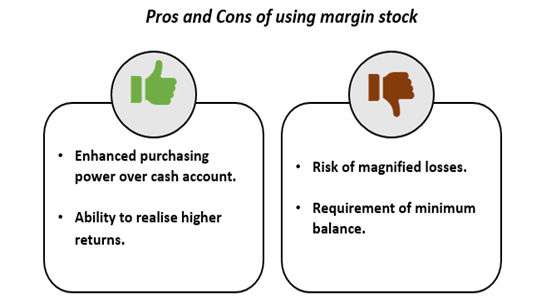What is margin stock?
Margin stock is collateral used to cover the credit risk of an investor. Part of stocks held that investors deposit with a broker or an exchange as protection from the risk they pose to the broker or the exchange. The risk is higher in short selling or derivatives trading,; it is then that margin stocks provide coverage.
Margin stock is generally used when broker makes initial payment; the marginal securities in investor’s brokerage account act as collateral. Using margin stock, investors qualify for borrowing funds to buy more stock to increase their returns. It is called margin trading. The stock margin requirements are often specified by a stock exchange for all participants dealing in securities over its platform.
Summary
- Margin stocks are the securities used by investors to borrow money from their brokerage to pay for a stock purchase using them as margin assets or collateral.
- Margin stock adds the ability to invest into a highly in-demand stock. It even enhances an investors' trading ability.
- Margin trading comes with equal risks and returns on any upside or downside movements.
- It is important to understand margin requirements to avail maximum benefits of margin stocks.
Frequently Asked Questions (FAQ)
What is margin trading?
In a case where many traders seek to buy one stock, they either deposit required cash into a brokerage account or save up the returns on existing investments.
Another handy way is to borrow money from one's broker against the stocks already in the investor's account. This is known as margin trading. In it, the broker lends money to investors at relatively low rates. The money received gives investors instant and extra buying power for eligible securities.

Source: © Pplahotya | Megapixl.com
In margin trading, the investors trading account and all assets hold serve as collateral for the borrowed money. In such cases, the broker doesn't share any of the risks. Instead, the brokerage lends funds for buying stocks. Thus, regardless of how securities perform, the investor will need to repay the loan.
Often a separate account for margin trading, called 'margin account', is set up. It is distinct from a 'cash account' and is a standard account most investors open for trading purposes.
All shares, bonds and other securities held in a margin account act as collateral for the margin loan. If an investor fails to repay the margin by depositing additional assets, the broker may sell off existing investments.
Margin stock maintenance requirements are determined by the stock exchange and may vary on all platforms. Essentially it is a ratio between holdings and the amount investors owe. In simple terms, it is just how much one borrows against investments held. Interest rate broker charges on margin loans are subject to change as well. When brokers call for the lent money, it is called a margin call.
How are margins calculated?
For trading on margins, it is important to understand how margins are calculated. A margin is a difference between the market value of stock and loan amount.
To compute the margin required to go long on stocks, one can multiply the number of shares by the price and a margin rate. Similarly, a short sale margin requirement plus 100% of the security value may be taken.
Margins thus can escalate investors profits on the upside and magnify losses on the downside. If a stock plummets severely, investors can end up with a margin loan exceeding the market value of stock used to loan the trade.

Source: © Convisum | Megapixl.com
Example
Let's consider that Mr Zen deposits $100,000 to his new margin account. His attached brokerage works on a 50% margin maintenance requirement and takes a 7% interest on loan funds under $5,00,000.
Now one day, Mr Zen decides to buy shares of Microsoft company. He wants to purchase shares worth $70,000 but has only $20,000 in his cash account. In such a case, by using a margin debt, he borrows the maximum amount allowable, $50,000 (50% of $100,000). So he can now invest $70,000 using these funds.
While repaying the loan from his brokerage, Mr Zen will have to repay $50,000 plus a 7% interest. The amount will remain like debt on Mr Zen even if his investments don't perform well. If he doesn't pay as per exchange or broker policy, the broker may cease the amount remaining in the margin account, or the amount from the cash account may be used.
What are the pros and cons of using margin stock?

Source: © 2021 Kalkine Media
Pros
- Using margin stock enhances an investors' purchasing power. With margin trading, investors can buy more than their cash account limits. If there's an investment the investor is pursuing, their ability to invest in it increases significantly more.
- Investors can realise higher returns by investing using the enhanced funding capacity. The more stock investor can buy, the higher is their earning potential. It means that using margin stock well amplifies an investor's returns.
Cons
- Using margin stock for trading magnifies the risk of losses. Investing using borrowed funds has a multiplicative effect if an investment loses value. Furthermore, failure to cover losses from margin trading can cause bankruptcy too. Though it is much easier to borrow funds using margin stock as collateral, the risk and reward on investment both get magnified.
- Investors who use their margin stock for trading are expected to maintain a minimum balance in the margin trading account at all times. If the balance falls below the minimum balance, a broker will intimate the investor to fulfil it. If investors cannot maintain the minimum balance, they would be forced to sell existing assets to maintain the minimum balance.
 Please wait processing your request...
Please wait processing your request...